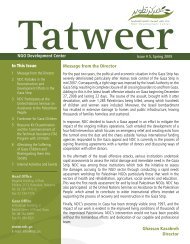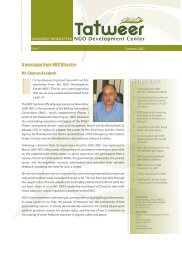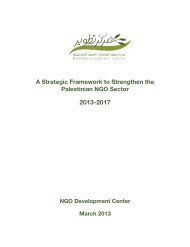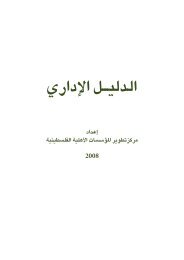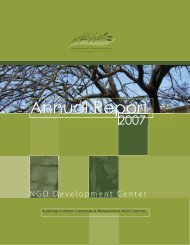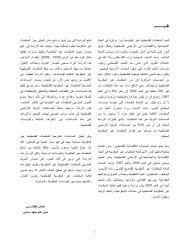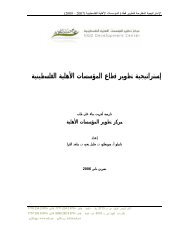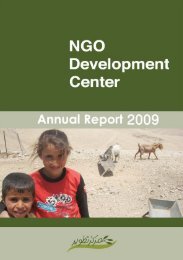Tracking External Donor Funding.pdf - NDC
Tracking External Donor Funding.pdf - NDC
Tracking External Donor Funding.pdf - NDC
You also want an ePaper? Increase the reach of your titles
YUMPU automatically turns print PDFs into web optimized ePapers that Google loves.
3.8.4 Geographic Distribution of <strong>External</strong> <strong>Donor</strong>s’<br />
Partner PNGO HQs<br />
Our geographical survey asked two different questions:<br />
where are the HQs of your partner PNGO, and where is<br />
the location of the project or program’s implementation.<br />
Over the ten year period, interesting patterns emerged in<br />
terms of the location of the external donors PNGO<br />
partner organizations.<br />
The Gaza Strip, even if well-represented in the first<br />
years, declines steadily throughout the decade, with the<br />
exception of 2006. After this slight increase the<br />
percentage of partnerships falls by nearly 10% between<br />
2006 and 2008, perhaps in response to the takeover by<br />
Hamas.<br />
Partnerships with PNGOs in the Northern and Southern<br />
West Bank remain low throughout the decade, at or near<br />
10%.<br />
Figure 37: The Location International <strong>Donor</strong>s’ Partner PNGO<br />
HQs by Region (1999-2008)<br />
80%<br />
70%<br />
60%<br />
50%<br />
40%<br />
30%<br />
20%<br />
10%<br />
0%<br />
1999 2000 2001 2002 2003 2004 2005 2006 2007 2008<br />
N. WB C. WB S. WB GS<br />
Source: MAS, 2009 – <strong>Donor</strong> Survey<br />
Partnerships with PNGOs located in the Central West<br />
Bank, on the other hand, rise rapidly in the early years of<br />
the study, and steadily afterwards until 2008, with the<br />
exception of a slight dip between 2003 and 2004 47 . By<br />
2008, 66.8% of international donors' partner PNGOs are<br />
located in the Central West Bank.<br />
In terms of Governmental versus INGO donors, the<br />
former have a higher percentage of partnerships in the<br />
Central West Bank, presumably as it is home to<br />
Jerusalem and Ramallah, the political capitals of the<br />
WB&GS. INGO donors closely mirror the overall<br />
trends, with the exception of having fewer partnerships<br />
in the Northern West Bank. Between 2006 and 2008,<br />
INGO partnerships with PNGOs in the Gaza Strip<br />
decreased by nearly 10%, with a corresponding 12%<br />
increase in the Central West Bank.<br />
3.8.5 Geographic Distribution of <strong>External</strong>ly<br />
Funded Project Implementation<br />
After having learned where international donors' PNGO<br />
partners are headquartered, we sought to find out the<br />
location of the implementation of the projects they were<br />
funding..<br />
As shown in the Figure 38 below, the Central West Bank<br />
receives the highest percentage of international aid in<br />
terms of project implementation. At 34.2%, the region<br />
receives nearly double the aid in proportion to its share of<br />
the population (17.8%). Only the Southern West Bank,<br />
mostly due to Bethlehem, is the share of aid also higher<br />
than the share of total population (23.5% and 18.9%<br />
respectively).<br />
47<br />
During this same year, the percentage of partnerships in the Southern and Northern West Bank both rise.<br />
52


